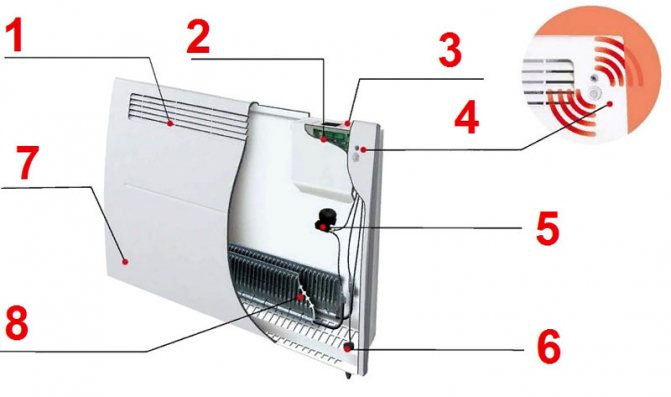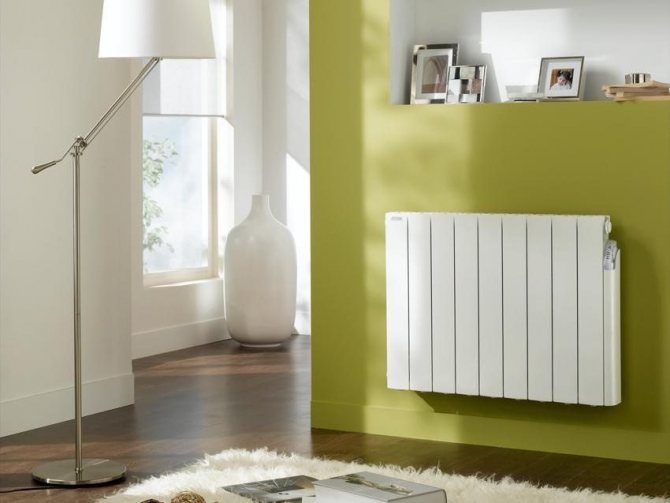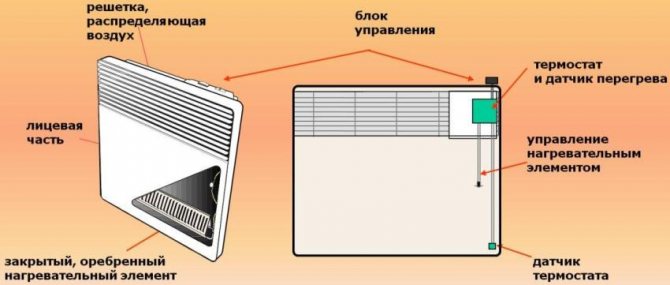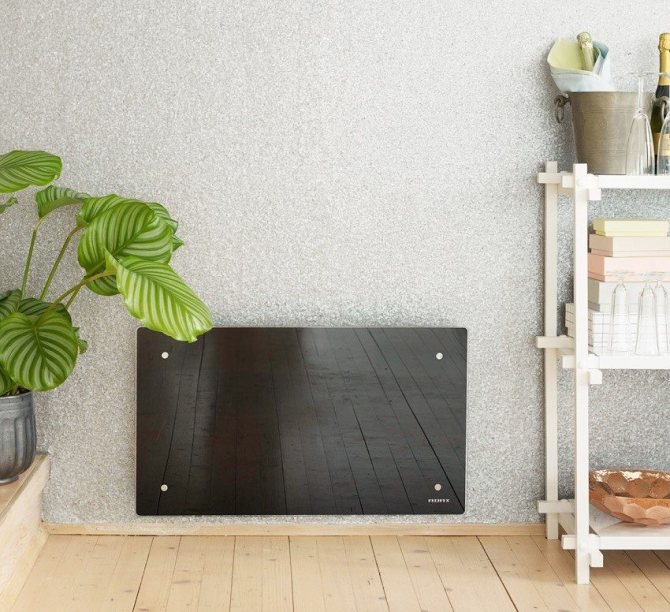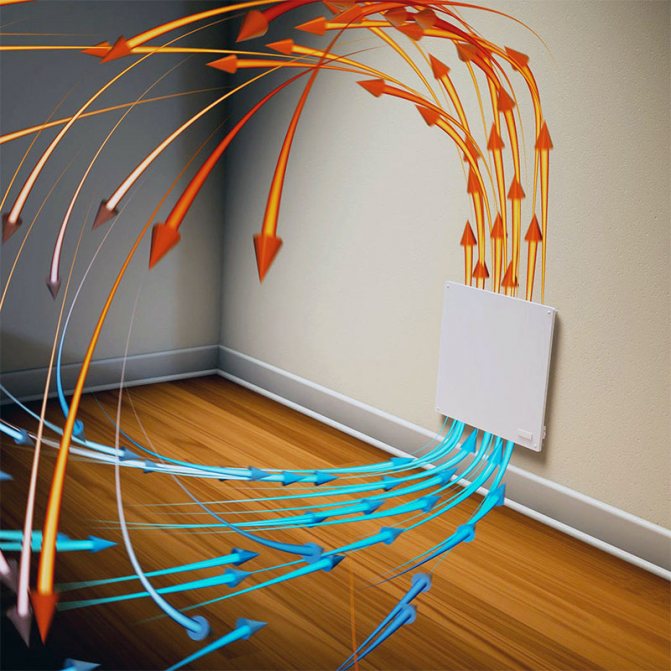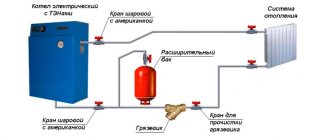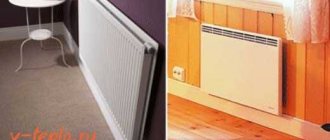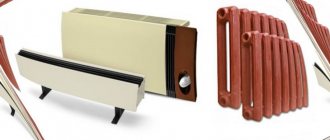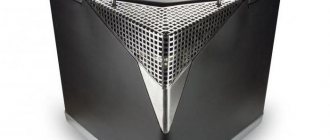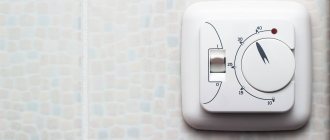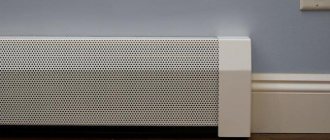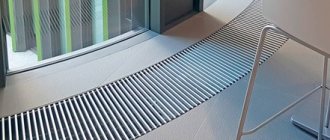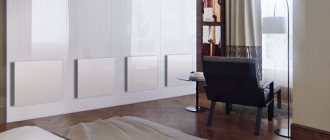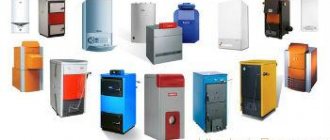A residential facility can be equipped quickly and inexpensively if you use a special category of equipment. Wall-mounted electric heating convectors with a thermostat are offered by well-known brands and new manufacturers. The wide range of thematic offers creates problems even for experienced professionals. To make the right choice of the best option, read the materials in this article.

Using a convector is an environmentally friendly way to create comfortable conditions
Choosing the best electric convector, how not to make a mistake when buying
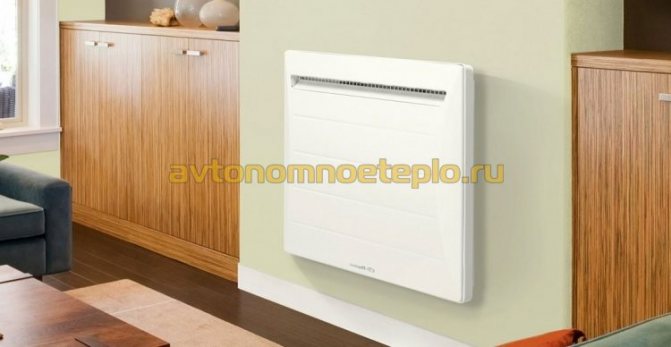

Electric convectors are especially popular. The capacity of the installations is sufficient to heat an apartment or a private house. Considering that there are several dozen different modifications on the equipment market, the question of which electric convector is better is asked by almost every buyer of climate technology.
How does an electric convector work
In this regard, the question arises, an electric convector - what is it? This is a device using the principle of convection of air masses. The air heated with the heating element rises upward. After cooling down, it goes down and again falls into the heating block of the device.
To ensure continuous convection, air ducts are provided in the housing through which air is drawn in and out.
The principle of operation of the electric convector may differ slightly depending on the type of heating element used and the presence or absence of pressure equipment (fan).
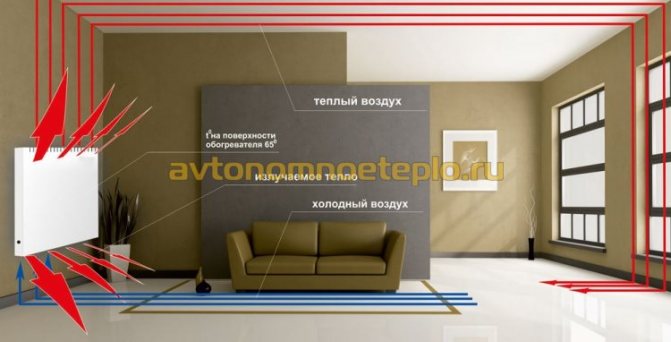

Hot water air heaters
This group of heating devices is characterized by the fact that it does not produce heat on its own. Water convectors serve only as a transfer link between the boiler plant and the air masses in the building. The boiler consumes energy, generates heat, which is delivered to the heaters with the help of a coolant - water.
Such convection heating of a private house should not be confused with radiator heating. The fact is that the proportion of infrared radiation in radiators is quite high, much more than 10%. Therefore, it would be wrong to classify them as a convector group.
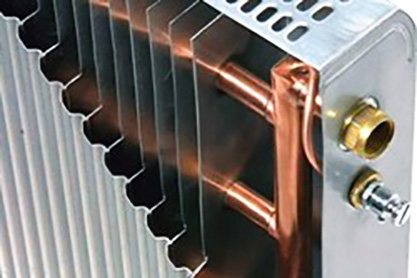

A striking example of a water convector is a coil made of a steel pipe with plates mounted on it, which is still found in apartments of multi-storey residential buildings. Sometimes you also come across devices hidden by the casing. In principle, this heater reflects well the general concept of direct air heating. Vertical thin plates warm up the air passing through them well and at the same time emit a little radiation, since they have too small an area. And devices, covered with a casing, emit very weakly in the infrared range.
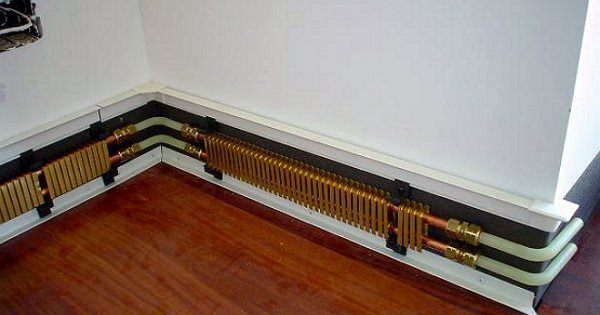

Nowadays, a convector heating system with wall-mounted appliances is quite rare. The reason is that it is not so easy to find wall-mounted water convectors, they have been completely replaced by various radiators. Nevertheless, there are such types of water air heaters on the market:
- skirting boards;
- indoor.
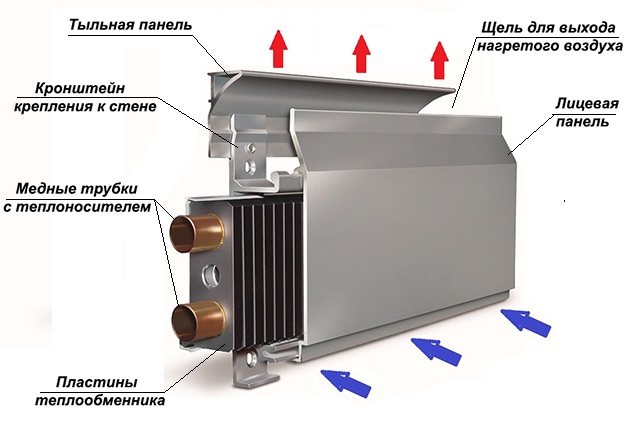

The first are modules with a finned heat exchanger made of copper or aluminum. The design is classic: plates installed on pipes with a coolant. The element is small and fits inside an aluminum casing with air slots. Modules are mounted around the perimeter of the room instead of skirting boards.
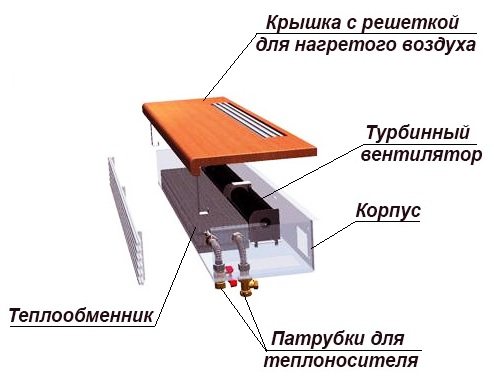

A similar convector-type heating is done on the basis of underfloor heaters.Here the classic finned heat exchanger is built into a casing with a grill instead of a top cover. The apparatus for increasing heat transfer is often equipped with a turbine-type fan. The product is completely hidden in the floor, only the grill through which the air circulates is visible.
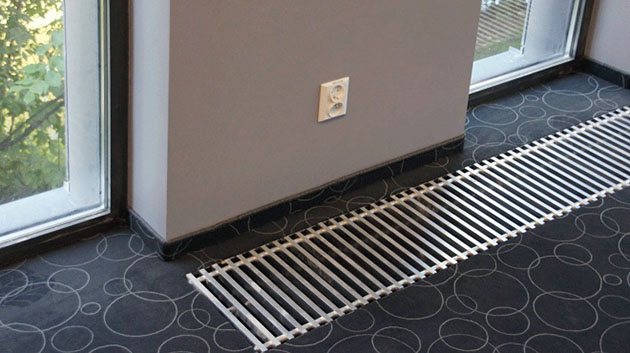

The main trump card of this kind of systems is versatility, because you can heat the coolant using any fuel or electricity. In this case, the efficiency and work should be assessed by the efficiency of the boiler, which depends on its type and the fuel used. As for the rate of room heating, it is quite high, and the heat consumption lends itself well to regulation. Another thing is that the cost of convector heating and its installation is quite high, and operating costs depend on the type of energy carrier.
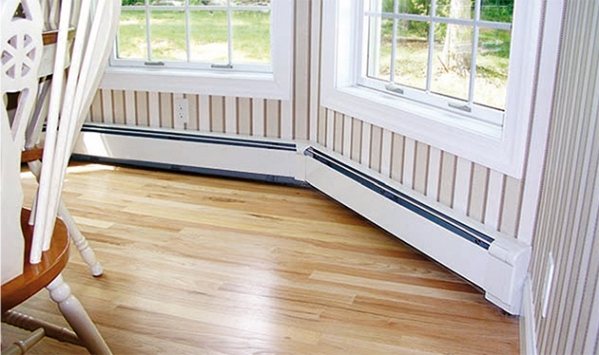

Types of electric convectors heating
When choosing climatic technology, it is important to take into account that electric convectors may differ from each other in the following characteristics:
- Mounting type.
- The heating element used.
You should also pay attention to the manufacturer of the product and the cost of electricity.
Types of electric convectors, according to installation features
Air convection heaters can be divided into three categories.
- Wall mounted. Wall-mounted convectors are the most efficient. The location on the wall facilitates the convection process and increases the efficiency and heat transfer of the heaters.
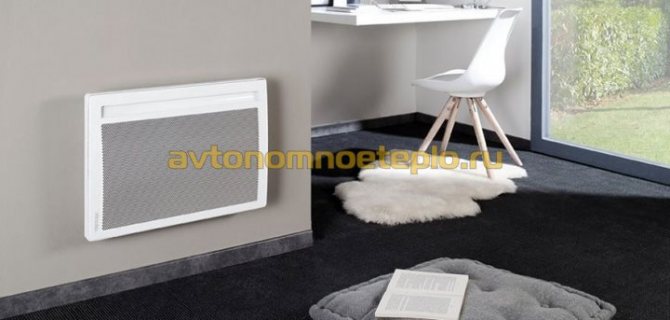

Floor-standing version - used as an additional source of heat. Models with a built-in fan differ in performance. The convector with forced air circulation cannot boast of quiet operation, but it warms up the air well.
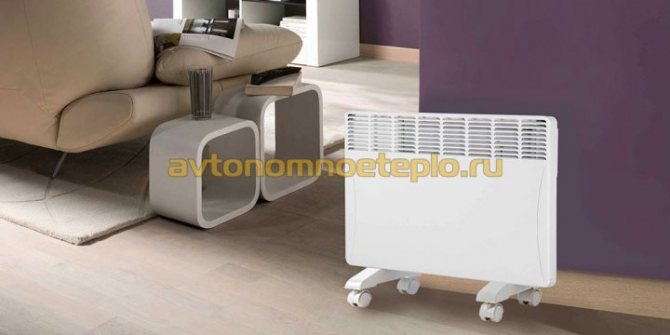

Classification of convectors according to the heating element used
Which company is the best electric convector to choose
After evaluating the pros and cons of the equipment offered to the domestic consumer, a small rating of convectors was compiled.
- The best option is Noirot Melodie Evolution - a new generation, premium class electric wall-mounted heating convector. Has a waterproof design, is mounted on the wall. With a monolithic heating element, which ensures almost silent operation of the device. Ease of control Noirot Melodie Evolution provides a touch panel or LED display (depending on the model). The programmer has several built-in operating modes and the ability to create your own heating schedule. A model with a remote control function is available for purchase. With the help of Noirot Melodie Evolution and a GSM alert system, heating a summer house or a country house with electric convectors has become completely safe and comfortable.
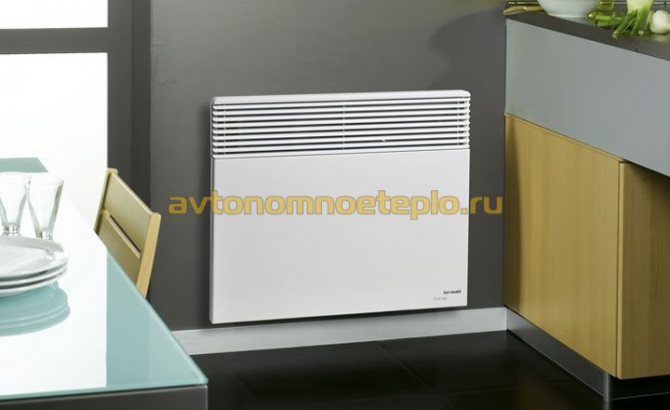

The middle class is Electrolux equipment. The company offers the consumer household wall-mounted electric heating convectors with a thermostat. Most Electrolux models are universal and can be installed on the floor at the request of the customer. It should be borne in mind that this will slightly reduce the performance of the device. A tubular or monolithic heating element is used as a heating element.
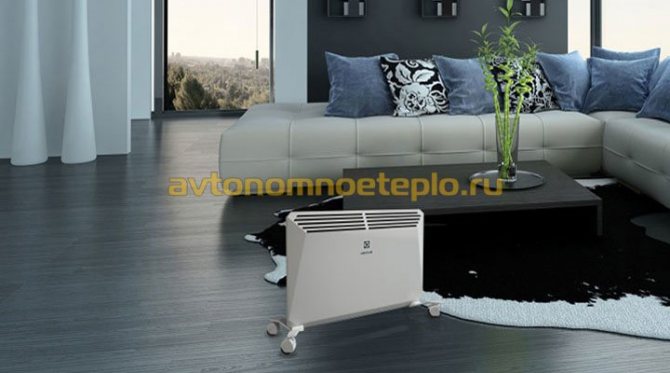

The budget version - convectors Ballu, Resanta and other Russian-made equipment. The domestic manufacturer has set up production of equipment with electronic control, a high degree of reliability and protection. The cost of equipment due to assembly at factories in Russia has been reduced by 1.5-2 times.
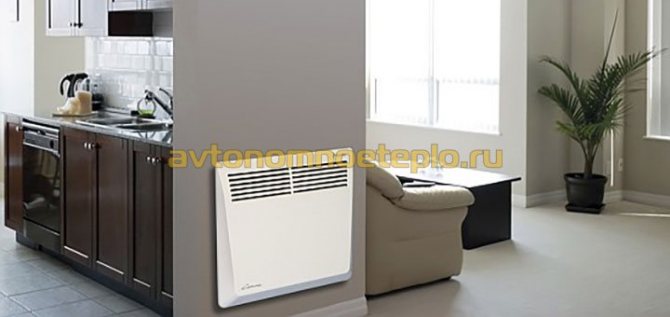

Advantages and disadvantages of electric convectors
The main advantages of electric wall-mounted heating convectors with thermostats:
- ease of installation - no need to lay pipes and cables;
- small dimensions - most models have a thin and light convection chamber;
- low heating of the body (up to 60-65 ° С), which makes the convector operation safe;
- The efficiency is close to 100% - almost all of the consumed electricity is spent on heating the air;
- ease of operation and maintenance - with electronic control, it is enough to set comfortable air parameters;
- ergonomic and safe design without sharp corners;
- environmental friendliness - during the operation of the convector, oxygen does not burn, the air is not polluted and does not dry out;
- long service life of the convector - up to 20 years;
- absence of noise, unacceptable smell, drafts and horizontal air flows, that is, those disadvantages that arise when using fan heaters;
- fast warming up of the room;
- automatic shutdown of the device in case of overheating of the heating element;
- energy saving - thanks to the thermostat, the device turns off when the set temperature is reached.
Reviews show that electric convectors have some disadvantages, including:
- dust transfer by convection air currents;
- unequal temperature in the upper and lower parts of the room, especially if the room is located above an unheated basement or the ceiling height is more than 2.5 m;
- low efficiency of the convector in the absence of high-quality insulation at home;
- the need to install several devices in a large room.
In addition, the use of heating convectors entails an increase in energy costs. Heating a house with a living area of about 80 m² is spent on average 1730 kW per month.
How to calculate and choose an electric convector
In fact, choosing a convector on your own is not so difficult. It is enough to take into account a few important aspects and make simple calculations.
We calculate the required power of the convector
During the calculations, several important nuances must be taken into account:
- Calculation of the power of the convector by the area of the room. Provided that the room is well insulated and has a ceiling height of no more than 2.7 m, 1 kW of thermal energy will be sufficient for every 10 m² of heated area. For a bathroom of 6 m², one heater per 1 kW should be enough. Bedroom of 20 m² - convectors with a capacity of 2 kW.
- Number of windows. The principle of operation of devices is associated with the use of convection, this in a certain way makes its own adjustments to the choice of heaters. The total heat energy required to heat a room should be divided by the number of window openings. So, for a room of 20 m² and having two windows, you will need to install 2 heaters of 1 kW each.
- The presence of heat loss. The technical characteristics of electric convectors given in the operating instructions of the device, in particular, the coefficient of the heated area, are taken taking into account the absence of significant heat losses in the room. If you have a non-insulated basement, walls of the house, you should choose a heater with a sufficient power reserve.
To figure out how to choose the right electric convectors for heating, in addition to the power of the device, it is necessary to take into account also the technical characteristics and functionality of the device.
Choosing an electric convector by functionality
How much electricity does the convector consume?
For convenience, the calculation of electricity consumption is made for permanent residence in a house with a heated area of 80 m².


The total power of convectors for the house will be 8000 watts.- Taking into account that the convector will not work in a constant mode, and when a certain temperature in the room is reached, it will be switched off, conventionally we take a coefficient of 60% as the electricity consumption per day.
- We calculate the cost of electricity per hour 8000 W × 60% = 4.8 kW per hour.
- Electricity consumption per day. Provided that an electronic or programmable thermostat is working, the heater will work during the day for no more than 12 hours.4.8 × 12 = 57.6 kW / day.
- 1728 kW will be consumed per month.
The result obtained may differ depending on the type of heater used, heat loss in the house and other parameters.
Does the electric convector dry the air?
A slight decrease in moisture is observed when using a fan This is especially noticeable if the heaters are operated continuously. Compared to heat guns, the convector does not dry the air at all.


As an additional measure to maintain a healthy microclimate, it makes sense to supply an air humidifier complete with an ionizer, or purchase a modification of the heater with a built-in device of this type. The control system itself will automatically monitor the humidity level and maintain it at the proper level.
Which is better, an electric convector or a fan heater
The fan heater heats the air instantly, passing it through a red-hot spiral. As a result, moisture evaporates and air dries out. It makes sense to use a fan heater where it is necessary to quickly warm up the room. It is not recommended to install such heaters as the main source of heating.
Unlike a fan heater, convectors operate in a safer mode. Thanks to this, you can even hang electric convectors on a wooden wall. The surface temperature of the case rarely exceeds 60 ° C.
Of course, you should follow the rules for installing electric convectors in a wooden house:
- The electrical wire is laid on top of wooden surfaces in a special fire-resistant corrugation.
- Foil-coated thermal insulation is placed under the wall-mounted heater.
- Floor electric heating convectors for wooden cottages are installed in such a way that the nearest wall is at least 0.5 m. There is no need to put non-combustible material under the heater.
Time has shown that the best solution is to install an electric convector. Although the device heats up more slowly than the fan heater, it provides complete operational safety, protection from fire, and also has a beneficial effect on the microclimate in a country house or summer cottage.
Features of choosing a convector
When choosing electric wall-mounted heating convectors with a thermostat, the price of which ranges from 2700 to 8500 rubles, you need to pay attention to:
- power;
- heating element;
- thermostat;
- additional functions;
- brand.
Power
Convectors are available with power up to 3.5 kW. This indicator must correspond to the operating conditions of the device. The main parameter is the area of the room. The recommended ratio is 1 kW of heater power per 10 m², provided that the ceiling height does not exceed 2.54 m. In addition, additional factors that affect heat loss should be taken into account:
- the number of walls bordering the street;
- the level of thermal insulation of the house;
- number and size of windows;
- climatic conditions in the region and so on.
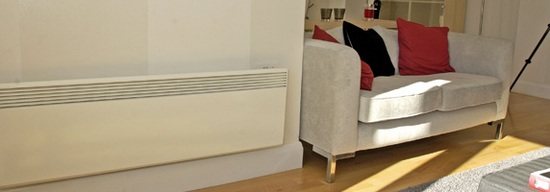

Wall mounted electric convector Nobo
Heating element
Products with a needle heating element are inexpensive, but their operation will not be durable and comfortable. Its openness increases the fire hazard of the heater. It is advisable to choose products with monolithic heating elements made of aluminum or ceramics.
Thermostat
The best thermostat option is electronic. They are characterized by high sensitivity to temperature changes, thereby saving energy and reducing the risk of fire hazardous situations.
Devices with a mechanical thermostat are cheaper, but such a device does not very clearly control the temperature regime and reacts more slowly to changes in room temperature.
The most convenient in operation are programmable electronic thermostats with remote control.As a rule, they contain several basic programs, but it is possible to make individual settings.
Additional functions
Various additional functions of the electric heating convector increase its cost, but expand the possibilities of use. Convenient options:
- humidification, ionization and air filtration;
- protection against water and steam (mandatory when installing the device in a room with high humidity);
- "Anti-freezing" - the device turns off if the temperature in the room drops below +5 ° С;
- different operating modes - "economy", "standard", "comfort";
- automatic shutdown when the heater falls;
- "Memorizing" the entered settings by the convector and their restoration after switching on;
- the ability to program the operation of the convector, for example, to set the desired temperature at certain hours.
Brand name
When buying a convector, it is important to consider the manufacturer's reputation. Brands such as:
- Nobo (Norway) - produces various models of heaters, pays special attention to the reliability of the heat exchanger and protection of equipment from power surges;
- Noirot (France) - produces durable and easy-to-use premium class devices in various modifications;
- Electrolux (Sweden) - offers quality products related to the middle price segment.
The best convectors
One of the most common heating devices is a convector that runs on electricity or gas. Such a heat source is called highly efficient because it quickly heats up the air, does not take up much space, is quite reliable and can be equipped with additional functions. This ranking contains reviews of the best convectors of 2020. The experts provided useful information on the choice of models, and also pointed out the advantages and disadvantages of the devices.
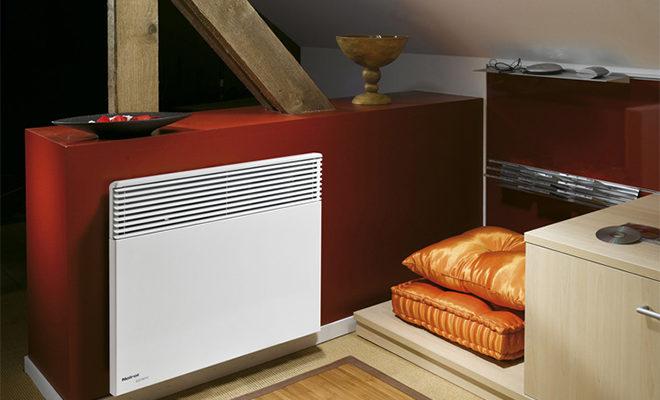

Which company convector is better to choose
Companies that produce convectors, as a rule, are engaged in narrowly focused activities - the production of heating devices. Surveys show that users prefer reliable, trusted firms that have a lot of positive reviews and a decent reputation. For review, brief characteristics were collected for each trademark:
- Noirot spot - a brand from France that produces heaters, manufactures and develops them only at its own enterprises, importing heat sources to more than 90 countries.
- Stiebel Eltron Is a brand from Germany that manufactures electric heating equipment. It has many subsidiaries in the territories of Asian and European countries, is a sponsor of sports and charitable events, and is one of the market leaders in the field of heating.
- Electrolux - a popular company from Sweden that produces household appliances for the home, produces climatic and professional equipment. The company's products belong to the middle and low price segment.
- Timberk Is another large corporation from Sweden that produces climatic equipment. It focuses on the production of a wide range of products, from simple water heaters to functional split systems.
- Resanta Is a Latvian brand that manufactures electrical goods. Offers a large selection of convectors, heaters, voltage stabilizers at average prices. Every year the company participates in international exhibitions, where it presents its own developments.
- Hyundai - a large holding from South Korea that manufactures consumer electronics. In creating its products, the company uses only modern innovative systems aimed at making the use of goods more comfortable.
- Ballu Is a Russian trade mark that produces HVAC equipment for industrial and domestic purposes.It has production facilities not only in Russia, but also in China, uses only high-quality raw materials.
- Scoole - a manufacturer from Russia, produces climatic equipment for the home, offering a large range of air conditioners, split systems, fans. It sells goods on the territory of the Russian Federation and the CIS countries, in compliance with strict international quality standards.
- Power KVZ Is another Russian company producing climatic equipment. The production uses components of well-known brands, which ensure the reliability, safety, quality of devices.
- Varmann - the largest trade mark producing convectors, heat exchangers, facade heating systems. It sells goods to Russian and European markets, gives long warranty periods for all products, accepting orders for individual projects.
- KZTO Breeze - a plant for the production of heating equipment, for 20 years has been occupying a leading position among Russian manufacturers. The advantages of the company include reliability, style, reasonable price for premium goods.
- iTermic ITTZ - a trademark of the Rada-M company, which produces heating devices. It manufactures premium class products, provides long-term guarantees, and uses high-quality raw materials in production.
Convectors rating
When compiling the rating, reviews of real people and the opinions of experts who selected the nominees were taken as a basis. Also, testing was carried out, which helped to identify the advantages and disadvantages of thermal equipment. When selecting participants in the TOP, the following criteria were taken into account:
- Device type;
- Quality of materials;
- Safety;
- Thermal power;
- Heat source;
- Heating area;
- Installation method;
- Thermostat;
- Price.
Analyzing the listed properties and conducting thorough tests, experts have selected the best convectors from the 2020 models. Another condition for entering the TOP was the ratio of price and quality.
Analysis and rating of the best electric convectors for summer cottages and houses
Providing an optimal microclimate at home or at work is a very important task. The required air temperature in the room provides comfortable conditions for both work and rest. But choosing a heater is not easy. This is due to the variety of models on the market. The right approach to evaluating equipment guarantees a purchase that you won't have to regret. To find the best convectors for your home or office, you need to outline the main criteria for choosing a device.
Working principle and classification
The design of the device for generating heat is quite simple: housing, air ducts, heating element, equipment for connection. The principle of operation is also not difficult: cold air from the environment enters the device. With the help of additional devices, it heats up and is released through the opening at the top of the device.
To conserve energy and maintain an optimal temperature, space heaters are equipped with temperature sensors. The main advantage of convectors over similar heat sources is safety. The temperature on the body of the device does not exceed + 60 ° C.
In this video, you will learn how to choose a heater:
Convector classification:
- by mode of action (water, electric, gas);
- by type of fastening (floor, wall, universal);
- according to the design of the heating element (monolith, heating element, needle).
Water convectors are suitable for installation in both autonomous and central heating systems. It is impractical to place them in rooms with high wall heights. With forced air circulation in the room, the operation of the device will be ineffective.
The advantage of gas convectors in comparison with water heaters is the independence of operation from low temperatures.The disadvantages include the significant dimensions of the installations, increased explosiveness. The best choice for heating apartments and summer cottages is electric convectors.
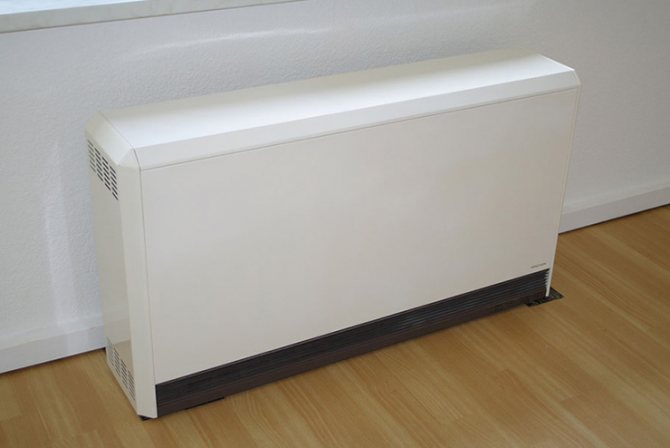

Convectors differ, at least in the way of fastening
Wall mounted electric heating convector
Among the variety of modern heating devices, an electric wall-mounted convector is the best option. It takes up a minimum of space and saves space in room.
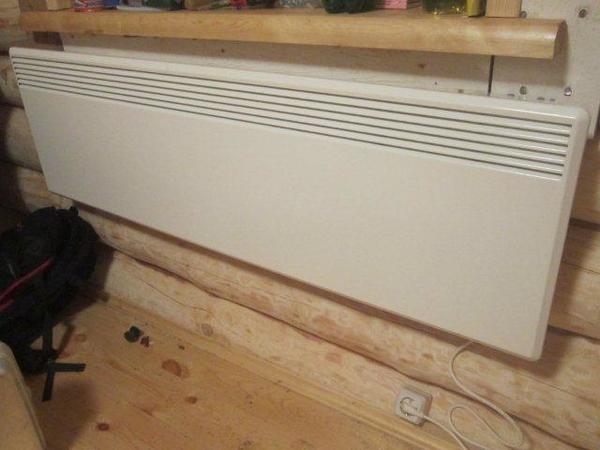

Photo 1. Wall-mounted electric convector for space heating. There is an outlet near the device for connecting it to the network.
Design and principle of operation
The design of the device is simple. It consists of the following parts:
- metal case with a grill at the bottom and exhaust curtains at the top;
- closed heating element (TEN);
- air temperature sensor;
- thermostat;
- power button.
Important! Modern models additionally equipped with overheating protection in the form of a special sensor that turns off the device.
Externally, the wall-mounted electric convector resembles a familiar heating radiator. Convector operation based on natural circulation of air currents. Cold air enters the body of the device through the lower grill, warms up, becoming lighter, then, under the influence of gravity, it is displaced by a new portion of cold air and comes out through the upper guide curtains. Mixing with air masses, it cools and re-enters the converter housing.
The process takes place continuously, as a result the room warms up evenly. The thermostat built into the convector is responsible for regulating the temperature level in the room. Its function is to turn off the device when the set temperature is reached and turn it on when it drops.
Advantages and disadvantages
The electric convector provides the main and additional heating of the air. Compared to traditional heating systems it has several advantages:
- Efficiency combined with quietness. In terms of heating speed, the convector is inferior to fan heaters. However, it uses less energy and works quietly, with barely audible clicks.
- Soft warming up air without overdrying.
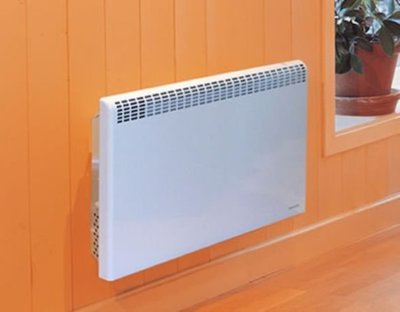

- Compactness.
- Simple, self-assembly and convenient operation.
- No special maintenance required and installation approval.
- Ergonomic design. Convectors fit well into the interior of any room.
- Affordable price.
Disadvantages:
- Decrease in efficiency as you use it.
- The need for frequent wet cleaning premises for elimination of dust circulating in the air. This circumstance should be taken into account for people prone to allergies and suffering from diseases of the respiratory system.
- Low efficiency in large areas.
Installation rules
To install the convector, a minimum of space is required, so it can be placed in any part of the room. But during installation, the main thing is adherence to recommendations for ensuring efficient operation and normal air circulation:
- height from the floor - 20 cm;
- clearance from the wall - 20-25 mm .;
- distance from side objects - not less than 50 cm;
- clearance top and front - not less than 50 cm.;
- distance to socket - not less than 30 cm.;
- wiring withstand voltage minimum 3.5 kVt.
Main characteristics
Since a convector is a thing that is bought for long-term use, you need to approach the purchase responsibly. Heaters are evaluated for different characteristics. You can quickly navigate when choosing a device by highlighting its most important parameters.
Indicators to pay attention to before buying:
- method of fixing the device;
- power consumption;
- type of thermostat;
- type of heater;
- security.
By arrangement, convectors are wall-mounted, floor-standing and universal.When purchasing a wall heater, it is necessary to clarify whether the fixture parts are supplied with the device. Some models do not have them, they have to be purchased separately. The advantage of this type of convectors is in saving space: they do not take up additional space in the room, which is essential for rooms and apartments with a small area.
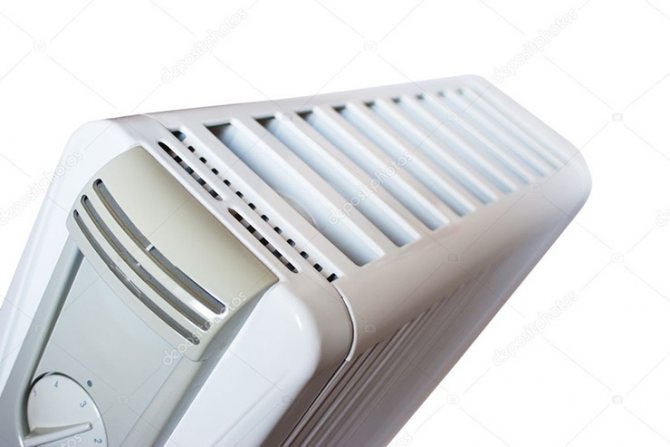

Do not forget to look at the power consumption of the convector when buying it
Floor heaters are equipped with feet or castors. Their advantage is mobility. By moving them, you can achieve the required temperature in all hard-to-reach areas of the room.
The most practical are convectors of a universal type. They can be installed on the floor or hung on the wall. When buying, you should check the presence of wheels or legs in the package: sometimes you have to buy them separately.
One of the decisive factors when choosing a heater is its capacity. If you bought a device with an underestimated value, it will not be possible to achieve the optimal temperature in the room. Overpowering is a guarantee of an inexpediently high cost of the device.
It is necessary to take into account the purpose of the convector (single heat source or auxiliary). If it is needed in an apartment as an additional heater, then one kilowatt of device power will be enough for a room with an area of 20 square meters. In the absence of main heating, you should choose equipment for a microclimate with a high power value.
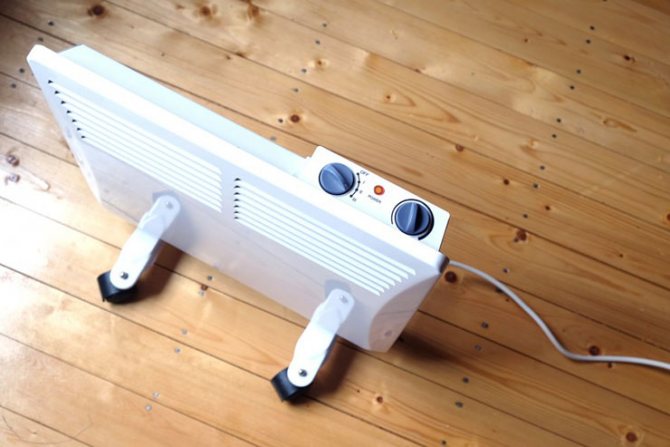

Will the convector be an additional heater or a main heater?
Convector thermostats can be of two types:
The nuances of installing the convector
Wall-mounted electric convectors with a thermostat are very easy to install. The product package includes all the parts necessary for fixing, as well as installation instructions. Typically, installation takes place in one of three ways:
- brackets are rigidly fixed to the body of the device, which are hung on hooks fixed on the wall;
- brackets are rigidly screwed to the wall, on which the convector is installed;
- clamps are attached to the vertical surface, which can be easily removed, the heater is hung on them using movable brackets.
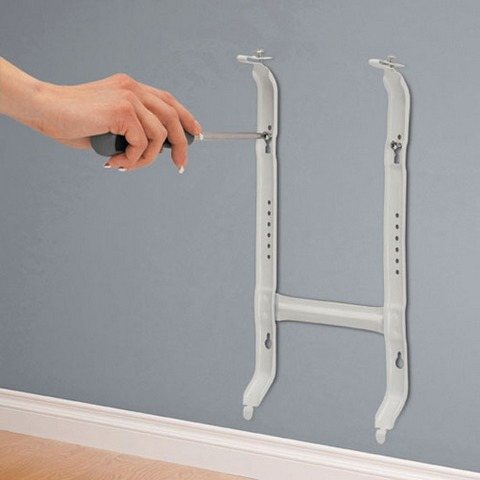

Mounting the electric convector on the wall with brackets
In any case, you will need to make several holes in the wall and screw the screws into them. It is better to mount the heater under the window closer to the floor. Important rules:
- when choosing a place for a convector, one should take into account the need for gaps between it and surfaces (floor, window sill, walls), gaps on all sides are required for air circulation;
- the heater should not block the outlet, it should be placed at a distance of at least 35 cm from it along a horizontal line (to prevent a short circuit), it is better not to use extension cords;
- if the power of the convector is more than 2.5 kW, it is better to consult with an electrician about the installation of power lines before installation.
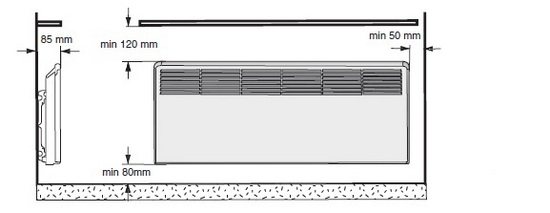

Installation diagram of a wall-mounted convector for heating
Convectors can be mounted on wooden walls, but some nuances must be taken into account:
- it is better to use a fireproof corrugation for laying the electric wire on top of a tree;
- a foil-clad heat-insulating covering should be laid under the device.
When installing several convectors as the main heat sources, it is worth inviting specialists. They will make all the necessary measurements and offer the best option for placing the heaters, taking into account the specifics of the premises and the possibilities of the electrical network.
Electric wall-mounted convector-type heaters are an excellent alternative to fan heaters, oil batteries and other similar devices. They quickly raise the temperature in the room, do not make noise, do not affect the humidity of the air and do not pollute it.Wall mounted devices are easy to install without requiring additional communications. Their main advantage is the presence of a thermostat that turns off the device when a certain temperature is reached. Equipping the product with an electronic control unit allows you to program its operating mode. But electric convectors are ineffective in very large and non-insulated rooms.
Additional functions
In convectors with electronic control, manufacturers offer a number of additional modes. Before buying, you should make sure that they are really necessary. The anti-freeze function will allow you to keep the minimum temperature in the room within + 5 ... + 7 ° C in the absence of the owners. At the same time, the bill for the consumed energy is small, since an empty dwelling will not overheat in vain.
Programming the operating modes allows you to set the necessary parameters at different times of the day, which will significantly save energy resources and the payment for them.
The remote control function facilitates the operation of the device for disabled and elderly people. Air ionization is useful for people who have to stay indoors for a long time, as well as for asthmatics and allergy sufferers.
It should be borne in mind that auxiliary functions provide additional comfort when using the device, but at the same time increase its cost.
How to choose an electric convector
The successful operation of an electric convector depends on the correct choice for which the following parameters affect:
- Appointment. If you intend to use the device as an additional element with poor performance of the main heating, you can limit yourself to a low-power model with a mechanical thermostat. It is preferable to choose an electronically controlled convector with additional functions as the main heat source.
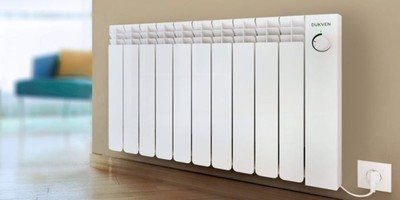

- To create a comfortable temperature, a device is used the power of which will be enough to heat a specific room... When choosing, take into account the area, the height of the ceilings, the presence of heat loss.
- An important condition for the safety of the convector is reliable case. Its height directly affects the power of the device and its convection ability. For a small area, a device with a size of 50-60 cm... The thickness of the case is equally important.
- When choosing a model, the type of thermostat is taken into account. Mechanical ones require human control, they do not withstand constant loads poorly. Electronic are distinguished by a high degree of reliability, economical in energy consumption, which justifies the increased price. The programmable ones are equipped with a remote control. Their inclusion can be done using GSM notification from a great distance.
Electric convectors rating
The most popular are heating devices that consume electrical energy. This is not surprising since There are quite a few advantages of this type of heater:
- ensuring the same temperature at all points in the room;
- noiselessness;
- work without accumulation of dust and unpleasant odors;
- during operation, humidity does not decrease, since oxygen is not burned;
- high heating rate;
- energy saving;
- small dimensions;
- ease of use and reliability.
There is no definite answer to the question of which electric convector is better. Products of such well-known brands as Noirot, Neoclima, Electrolux, Ballu, Timberk have been tested by many users and time. Therefore, the models of these companies often occupy first places in the ratings of the best electric convectors. Every day new manufacturers of microclimate household appliances appear on the market. The cost of the products they offer is slightly less due to the unknown, but it is difficult to judge their quality and level of reliability.
Electric convectors of the new generation are distinguished by their stylish appearance, the presence of a liquid crystal display, and an energy-saving mode of operation. In order to objectively evaluate a certain heating equipment, the place of its installation should be taken into account.
Household microclimate devices
For a dwelling with an autonomous heating system, in which people are constantly located, convectors select low power, since they mainly serve as additional sources of heat.
Top 5 best electric convectors for home heating.
Radiators and gas convectors
If point heating devices are sufficient to maintain the temperature in the room, it is recommended to install gas or electric convector-type heating. They consist of a heating element, a control unit and a combustion products evacuation system (gas models).
Electric heating convectors
Electric convector design
This is the easiest and fastest way to make heating in a house or apartment. An electric heating element serves as a heating element, the temperature of which is transferred to the body of the device. With the help of a system of slots, air freely penetrates into the inside of the radiator, creating convection.
The most common models for a convector heating system have a tubular heating element with metal plates. This increases the heating area. But the reviews speak of one drawback - during operation, extraneous sounds are heard. The reason for this is the expansion of the metal of the plates.
To install convector heating batteries, the following conditions must be met:
- The cross-section of the wiring must be designed for the maximum power of the device;
- It is recommended to install a separate RCD to prevent short circuits;
- According to safety rules, the convector must not be left on when there are no people in the house.
You also need to take into account the high energy costs. Therefore, in the presence of a gas main, convector heating batteries with a burner are chosen.
The cost of electric convectors ranges from 4000 to 15000 rubles
It is important to pay attention to the characteristics of the control unit, protection against water and the presence of automatic shutdown in case of rollover.
Gas convectors heating
Economical heating of a convector-type house can be done by installing gas models. They consist of a burner that is not located indoors. Air supply and combustion products are removed through a coaxial chimney.
Unlike convectors for electric heating, gas models are large in size. This is due to the presence of a gas burner and a sufficiently large heat exchanger. To improve convection, a fan is installed in some models to increase air exchange.
The average cost of gas convectors is 8000-12000 thousand rubles. Despite the large number of foreign brands, they prefer to purchase domestic counterparts. They are better adapted to specific operating conditions.
In what cases is the installation of convector heating at home justified. Reviews about him, the high cost of batteries and radiators indicate a balanced approach when choosing such a system. In most cases, it is relevant for small rooms and production workshops, where it is necessary to make zonal (selective) heating.
In the video, you can familiarize yourself with the features of the installation of gas convectors:

